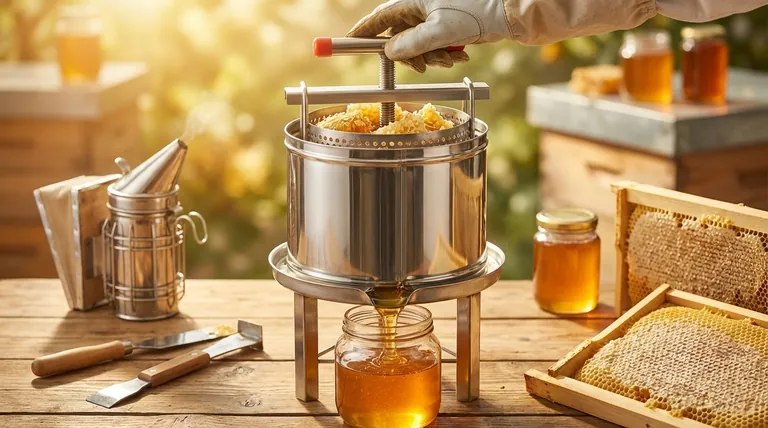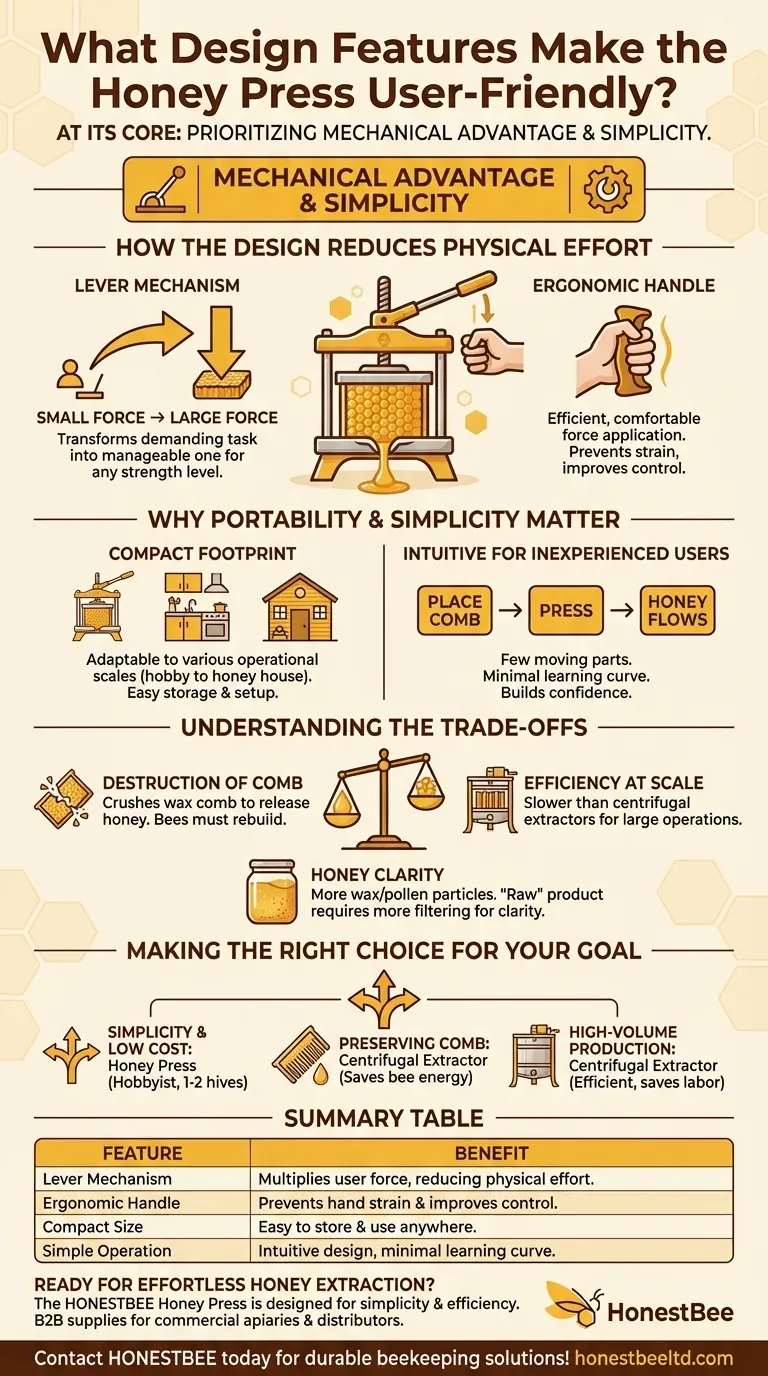At its core, the Honey Press is user-friendly due to a design that prioritizes mechanical advantage and simplicity. The primary features contributing to this are an ergonomic handle paired with a powerful lever mechanism, which significantly reduces the physical effort required for honey extraction. Its compact size further enhances usability by making it adaptable to various operational scales.
The true value of the Honey Press lies not just in its features, but in its focus on lowering the barrier to entry for honey extraction. It's designed to make the process less about physical strength and more about simple, repeatable mechanics.

How the Design Reduces Physical Effort
The primary challenge in honey extraction is applying enough force to separate the honey from the comb. The design of the Honey Press directly addresses this through mechanical engineering.
The Role of the Lever Mechanism
The lever is the most critical element for user-friendliness. It provides significant mechanical advantage, meaning a small amount of force applied by the user is multiplied into a much larger force exerted on the honeycomb.
This design transforms a physically demanding task into a manageable one. It allows a user of any strength level to effectively extract honey without strain or fatigue.
The Ergonomic Handle
A comfortable, well-designed handle complements the lever system. It ensures the user can apply force efficiently and comfortably over time, preventing hand strain and improving control during the pressing process.
Why Portability and Simplicity Matter
Beyond reducing physical effort, the tool's accessibility is key to its user-friendly nature. This is determined by its size and operational simplicity.
A Compact Footprint for Any Apiary
The Honey Press is designed to be compact. This makes it easy to store, move, and set up in various locations, from a small kitchen to a large, dedicated honey house.
Its portability is a significant advantage for hobbyists or beekeepers with limited space, removing a common barrier to setting up an efficient extraction workflow.
Intuitive for Inexperienced Users
The press has very few moving parts and a straightforward operating principle: place comb in, and press. This simplicity is invaluable for new beekeepers who may be intimidated by more complex machinery.
The minimal learning curve ensures a smooth and successful first experience, building confidence and encouraging continuation in the craft.
Understanding the Trade-offs
While user-friendly, a press is not the right tool for every situation. Its core design involves a fundamental trade-off compared to centrifugal extractors.
Destruction of the Comb
The most significant trade-off is that a press crushes and destroys the wax comb to release the honey. This means the bees must expend considerable energy and resources to rebuild that comb from scratch.
Efficiency at Scale
For small-scale operations, a press is often sufficient. However, for beekeepers managing many hives, a press is significantly slower than a centrifugal extractor, which can process multiple frames at once without destroying the comb.
Honey Clarity
Honey from a press often contains more fine particles of wax and pollen. While some prefer this for a more "raw" product, it typically requires more filtering to achieve the crystal clarity many consumers expect.
Making the Right Choice for Your Goal
Selecting the right extraction tool depends entirely on your beekeeping objectives.
- If your primary focus is simplicity and low startup cost: The Honey Press is an excellent, user-friendly choice for hobbyists or those with one or two hives.
- If your primary focus is preserving comb for reuse: A centrifugal extractor is the only viable option, as it saves your bees immense time and energy.
- If your primary focus is high-volume honey production: A centrifugal extractor is far more efficient and will save you significant labor in the long run.
Ultimately, understanding the trade-off between ease of use and comb preservation is the key to choosing the right tool for your apiary.
Summary Table:
| Feature | Benefit |
|---|---|
| Lever Mechanism | Multiplies user force, reducing physical effort required. |
| Ergonomic Handle | Prevents hand strain and improves control during pressing. |
| Compact Size | Easy to store and use in any apiary, from small to large. |
| Simple Operation | Intuitive design with minimal learning curve for all users. |
Ready to experience effortless honey extraction?
The HONESTBEE Honey Press is designed for beekeepers who value simplicity and efficiency. Whether you're a hobbyist starting out or a commercial apiary looking for reliable equipment, our press reduces the physical barrier to entry for honey processing.
At HONESTBEE, we supply high-quality beekeeping supplies and equipment to commercial apiaries and distributors through our wholesale-focused operations. Let us help you streamline your workflow.
Contact HONESTBEE today to learn more about our Honey Press and other durable beekeeping solutions!
Visual Guide

Related Products
- Stainless Steel Manual Honey Press with Guard for Pressing Honey and Wax
- 6 Frame Manual Stainless Steel Honey Extractor Beekeeping Equipment
- Easy Use Manual Stainless Steel Honey Press for Honey Comb
- HONESTBEE 3-Frame Manual Acrylic Honey Extractor
- Stainless Steel Honey Press Wax Press with Tank
People Also Ask
- What are the benefits of the screw design in a stainless steel honey pump? Preserve Honey Quality and Integrity
- What are the multipurpose functionalities of a honey press? Versatile Harvesting for Beekeepers & Homesteaders
- What was the overall experience with the honey press? Maximize Yield for Small-Scale Beekeeping
- What are the key features of a honey press? Maximize Yield with Durable, Efficient Extraction
- What are the uses of honey in various industries? Unlock Its Functional Power in Food, Pharma & Cosmetics



















